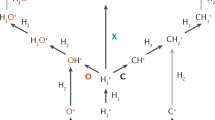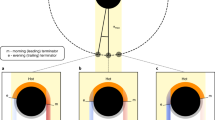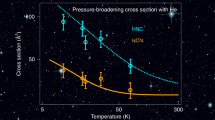Abstract
As a meteoroid evaporates, its vapours emit spectra of neutral atoms as well as ionic spectral lines. In the spectra of high velocity meteoroids, these ionized lines are the strongest feature, especially multiplet 1 (the H and K lines) of Ca II (multiplet numbers are those given in ref. 1). It is not sufficient, however, to attribute their excitation in the spectrum of bright meteors merely to the high velocity of the meteoroid. Strong Ca II spectra are also observed for slow meteoroids2. In addition, as the meteoroid penetrates the atmosphere, with little change or even a decrease in velocity, its ion spectra characteristically become progressively brighter. The spectrum at the beginning of the trail is predominantly from neutral atoms, while at the end it is from excited ions.
This is a preview of subscription content, access via your institution
Access options
Subscribe to this journal
Receive 51 print issues and online access
$199.00 per year
only $3.90 per issue
Buy this article
- Purchase on Springer Link
- Instant access to full article PDF
Prices may be subject to local taxes which are calculated during checkout
Similar content being viewed by others
References
Moore, C. E., A Multiplet Table of Astrophysical Interest (Revised Edition), US Nat. Bur. Standards Tech. Note 36 (US Dept. Commerce, Washington, 1959).
Ceplecha, Z., and Rajchl, J., Smithsonian Contr. Astrophys., 7, 129 (1963).
Neff, S. H., Astrophys. J., 140, 348 (1964).
Cook, A. F., and Millman, P. M., Astrophys. J., 121, 250 (1955).
Millman, P. M., Smithsonian Contr. Astrophys., 7, 119 (1963).
Baker, R. M. L., Astrophys. J., 129, 826 (1959).
Rajchl, J., Smithsonian Contr. Astrophys., 7, 155 (1963); Bull. Astron. Inst. Czechoslovakia, 15, 138 (1964).
Utterback, N. G., and Broida, H. P., Phys. Rev. Lett., 15, 608 (1965). Lipeles, M., Novick, R., and Tolk, N., Phys. Rev. Lett., 15, 815 (1965). Henderson, W. R., Mentall, J. E., and Fite, W. L., J. Chem. Phys., 46, 3447 (1967).
Utterback, N. G., and Miller, G. H., Phys. Rev., 124, 1477 (1961). Utterback, N. G., Phys. Rev., 129, 219 (1963).
Bukhteev, A. M., and Bydin, Y. F., Bull. Acad. Sci., USSR, 27, 985 (1963).
Mitchell, A. C. G., and Zemansky, M. W., Resonance Radiation and Excited Atoms, 217 (Cambridge University Press, 1961).
Kinslow, M., and Potter, J. L., Amer. Inst. Aeronautics Astronautics J., 1, 2467 (1963).
Author information
Authors and Affiliations
Rights and permissions
About this article
Cite this article
HOFFMAN, H., LONGMIRE, M. Meteor Ion Spectra. Nature 218, 858–859 (1968). https://doi.org/10.1038/218858a0
Received:
Revised:
Published:
Issue Date:
DOI: https://doi.org/10.1038/218858a0
Comments
By submitting a comment you agree to abide by our Terms and Community Guidelines. If you find something abusive or that does not comply with our terms or guidelines please flag it as inappropriate.



